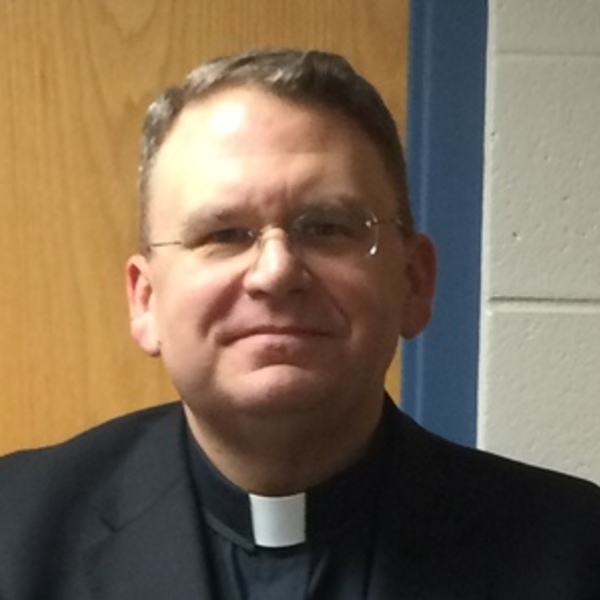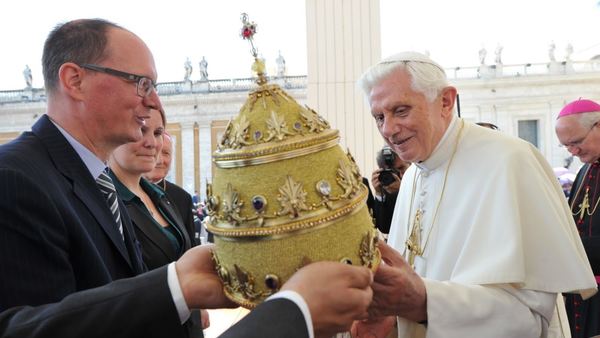They broke a pattern. For over a century, nearly every man who had been elected successor of St. Peter had been a trained papal diplomat: Leo XIII (1878–1903), Benedict XV (1914–1922), Pius XI (1922–1939), Pius XII (1939–1958), John XXIII (1958–1963), and Paul VI (1963–1978) had each served as nuncio (ambassador) in the Vatican diplomatic corps, with Pius XII even serving as papal secretary of state under his predecessor. The outliers were Giuseppe Sarto (St. Pius X, 1903–1914) and Albino Luciani, (John Paul I, who was pope for just a month in 1978). No doubt nearly every homily given, every public allocution uttered, or encyclical published by any of these great men was more than likely written for them, by a theological aide-de-camp or private secretary; often these ghost-writers were trusted priest-professors at one of the Roman universities: the Urbanum, the Gregorianum, or the Angelicum. Having assumed the Chair of St. Peter, most of these pontiffs did not think of themselves principally as theologians, but as pastors who had been entrusted with the supreme teaching office.
At the end of the twentieth century and the beginning of the twenty-first, John Paul II (1978–2005) and Benedict XVI (2005–2013) broke the pattern. In 1978 and again in 2005, the College of Cardinals opted for two scholars. Karol Wojtyła and Joseph Ratzinger—long before being made Cardinals—had distinguished themselves as first-rate thinkers. And as pontiffs, unlike their predecessors, each no doubt was the principal author of nearly every word they spoke or published. Wojtyła, deeply influenced by the personalist philosophy of Max Scheler, while at the same time the pupil of the eminent Roman Dominican, Reginald Garrigou-Lagrange, had a flair for original, philosophically sophisticated thinking, in particular in the area of theological anthropology and moral theology (hence, his programmatic Wednesday audiences popularly referred to as the “Theology of the Body”).
Benedict, equally gifted intellectually, had a slightly different cast of mind. Deeply steeped in the Fathers of the Church, and not having been educated in the Roman system, Ratzinger’s strengths lay in the depth of his erudition and knowledge of the Tradition as a living, organic reality, and further in his ability to communicate it in a way that was new, fresh, and truly beautiful. His Wednesday audiences were devoted to an ongoing catechesis on the Fathers and the Doctors of the Church. Benedict was deeply persuaded that the saints were themselves a “theological font,” a true source of wisdom about God and insight into the life of faith, and often more accessible to modern sensibilities than a theological treatise or an apologetic argument. Pope John Paul II had personally chosen Joseph Ratzinger as his close collaborator. As prefect of the Congregation for the Doctrine of the Faith from 1982 until his election as John Paul’s successor in 2005, Ratzinger worked together with the pontiff to chart the course of post-conciliar Catholicism. Three striking features of Pope Benedict’s theological work are its comprehensive nature and profound coherence, its deep integration of doctrina and vita, and its robust conception of the Word of God.
One need only read Ratzinger’s Introduction to Christianity, published in 1968, to recognize the coherence of his theological vision. The fundamental principles and themes that would echo thirty years later during his pontificate are already evident in this early work. Based on lectures he had given at the University of Tübingen the prior year, Ratzinger takes seriously the intellectual challenges facing the confession of faith in the modern period and tackles the matter head-on by an analysis of doubt. Yes, doubt is present even in the life of faith, Ratzinger concedes. But even the unbeliever—not merely the mild agnostic but even the harshest opponent of faith—does not argue from the high ground, from a position of necessarily intellectual superiority. Even he must concede that he himself, too, entertains doubt. After all, he has to consider the fact that perhaps—just perhaps—Christianity is true. One can read this book and draw numerous connections between the principles and themes enunciated in it and the later work of Ratzinger, both as a theologian and as the bishop of Rome. Ratzinger had a knack for understanding the questions that weigh on peoples’ hearts, as well as how the Catholic Tradition offers real answers, ones that truly respond to them at the deepest level—and can do so perennially—rather than ersatz, facile, and seemingly attractive solutions that only further impair this search for meaning by wedding the answer to the zeitgeist. And as a consummate teacher, he could also make those answers accessible and appealing to his contemporaries. Joseph Ratzinger, long before being pope, possessed a theological vision that was truly comprehensive and profoundly coherent.
Further, in tune with many of the ressourcement theologians of the mid-twentieth century (some of whom, like de Lubac and von Balthasar, he knew personally), Ratzinger emphasized the co-inherence of theological study and the spiritual life, the inter-penetration of theology and spirituality. Faith, prayer, and committed discipleship cannot and should not be “bracketed” or “cordoned off” for one who takes theology seriously. And to take theology seriously means not only hitting the books but also hitting one’s knees. Prayer is integral to the theological vocation, prayer that is formed first within the Church’s public liturgy and returns regularly to be nurtured there, and which enables the theologian a kind of understanding available only to those who love. Amor ipse notitia est, as Gregory the Great had taught, echoed a full millennium later by Blaise Pascal: le coeur a ses raisons que la raison ne connaît point: love itself is a kind of knowing, and the living God, the God of Abraham, Isaac, and Jacob is grasped not by mere intellectual cogitation alone. Pascal, a mathematician, had experienced God, and as a living fire. The Logos whose work is sung in the prologue of the Fourth Gospel is not the remote and disinterested thought-thinking-thought or unmoved mover of Aristotle, much less the cold, calculating “reason” of scientific empiricism, but a person. And indeed, this Logos is the one, the only one, who can offer order and meaning to our lives.
As pope, Benedict worried that the very concept of logos or “reason” had been suffering, since the early modern period, from a kind of sclerotic constriction, being narrowly limited to that which is empirically verifiable. Rather, in an attempt to restore the term to its full vigor, Ratzinger suggests that one helpful way of translating logos is as “meaning.” The very Logos of the Gospels, incarnate in the person of Jesus, reveals himself also as agape, a love that is willing to give itself entirely, and not merely as an abstract consideration, but in an embodied way. Benedict teaches us that if we are to find meaning in our lives, we must learn to die to ourselves, to give ourselves in love. Thus, our vita must not only reflect, but in fact embody, our doctrina: we must not only talk the talk, but we must also walk the talk.
Ratzinger’s rich conception of the revealed Logos no doubt stems from (and may also have been influential in the drafting of) what is probably the theologically richest document of the Second Vatican Council, Dei Verbum. In fact, Dei Verbum itself provides a key hermeneutic and functions as a lens for understanding the other conciliar documents. When most people hear the term “Word of God,” they immediately think of the text of Scripture; this is certainly true. But there is more. What the Council recaptures and reframes is that the Word of God is first and foremost a person, the incarnate Lord, Jesus Christ, the fullness of God’s self-revelation. As John of the Cross taught in his Ascent of Mount Carmel, in his Son, the Word-made-flesh, Jesus Christ, God has said all that he has to say. We await no further, additional revelation. Sacred Scripture and Sacred Tradition are akin to sacraments (in the loose sense) of that singular and unsurpassable revelation of God’s work in Christ, transmitted to us in written and unwritten modes.
A good deal of Joseph Ratzinger’s intellectual energy was spent unpacking the significance of this, not least for contemporary biblical scholarship—not principally as an academic exercise, but rather because of Ratzinger’s deep conviction that the Scriptures are to be read and interpreted in a way that communicates the living Word of God to the Church. For the Scriptures are not only to be read and interpreted (and indeed preached) but first prayed. Every encounter with the Scriptures is—or should be—a deeply intimate encounter with the person of the risen Lord Jesus, whose Spirit animates those very texts and who, in his incarnate person, provides the principle both of their unity and of their interpretation. The Foreword (a mere fourteen pages) to his 2007 English edition of Jesus of Nazareth is a game-changing tour-de-force on how the Gospels—and by extension, the entirety of the Scriptures, Old and New Testaments—are to be read, prayed, and preached. In this brief Foreword (itself worth the price of the entire book!), Pope Benedict is merely recovering the way—the ancient way—that the Church had always approached the Scriptures, and which was often forgotten or, at least beginning in the 18th and 19th centuries, shelved as passé.
Pope Benedict is by no means a fundamentalist: what he is certainly not doing is rejecting out-of-hand the advances that historical, archeological, literary, linguistic, and cultural research have made in the understanding of the Bible in its original context. Dei Verbum §12 makes clear that these are literally critical for determining the original author’s intent. But Dei Verbum §12 continues to posit with equal or greater assertiveness (and this has often been forgotten or ignored) that these texts must, by their very nature, be read within the entire living Tradition of the Church and with the eyes of faith, with the ultimate aim of knowing not only what the human author had intended, but more importantly what God wants to reveal to us today, right now. Critical scholarship is essential in helping us to understand what a sacred text meant. But the prayerful reading of the Scriptures, under the aspect of faith and within the living Body of the Church, reveals to us what the text means today, right now.
This does not disqualify or dismiss what it meant, but it does make clear that its meaning is not simply reducible to its original historical or literary context. Inspiration is not merely a matter of how God’s Spirit moves a sacred author (interesting as such questions may indeed be), but, more importantly, functions to assure us (and readers of every age and place) that the text of Scripture is a privileged locus of God’s self-communication—here and now, wherever that “here” and “now” happen to be—and not merely to peoples of the past. And further, the principal environment, the primary milieu, the freshest atmosphere in which the Scriptures live is the Sacred Liturgy itself, where the altar interprets the ambo, so to speak, as what Christ did once and for all is not only made present under the veil of the Sacrament, but itself opens up to believers the full meaning of the Scriptures.
Pope Benedict XVI was a model theologian because he was first (and remained) a model disciple: a lover of the Logos, a hearer of the Word, reclining on the breast of the Lord in prayer and taking as his own the Mother of God, the type and figure of the Church, whom he served with fidelity and love. Requiescat in pace.
Editorial Note: A version of this essay also appears inThe Brownson Record, an independent student publication of Mount St. Mary’s University; it appears here with the permission of the editor.


